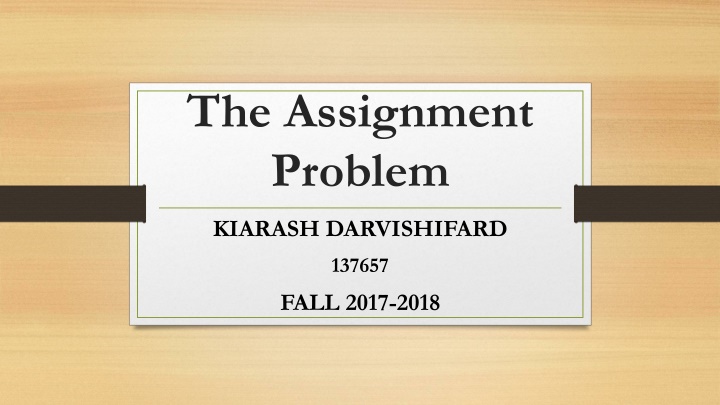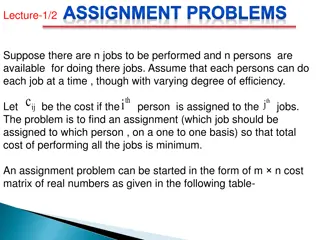The Assignment Problem
The Assignment Problem by KIARASH DARVISHIFARD during the Fall semester of 2017-2018 covers a detailed exploration of a specific issue or task. This assignment may involve problem-solving, critical thinking, and analytical skills. The task could be related to various subjects or disciplines and is aimed at enhancing the student's understanding and knowledge in the respective area.
Download Presentation

Please find below an Image/Link to download the presentation.
The content on the website is provided AS IS for your information and personal use only. It may not be sold, licensed, or shared on other websites without obtaining consent from the author.If you encounter any issues during the download, it is possible that the publisher has removed the file from their server.
You are allowed to download the files provided on this website for personal or commercial use, subject to the condition that they are used lawfully. All files are the property of their respective owners.
The content on the website is provided AS IS for your information and personal use only. It may not be sold, licensed, or shared on other websites without obtaining consent from the author.
E N D
Presentation Transcript
The Assignment Problem KIARASH DARVISHIFARD 137657 FALL 2017-2018
The Assignment Problem In numerous business conditions, administration needs to give staff to jobs, machines to job areas, jobs to machines, or - sellers to regions. Consider the condition of appointing n jobs to n machines. When a job i (=1,2,....,n) is appointed to machine j (=1,2, .....n) that causes a cost Cij. The target is to appoint the jobs to machines at the minimum possible whole cost.
The Assignment Problem This condition is a specific case of the Transportation Model And it is defined as the assignment problem. Here, jobs demonstrate sources and machines demonstrate destinations. The supply available at every source is 1 unit And demand at every destination is 1 unit.
The Assignment Problem The assignment model can be represented mathematically in this way: Xij= 0, if the job j is not appointed to machine i 1, if the job j is appointed to machine i
The Assignment Problem Example KLM engineering manufactures Mechanical shaft seal. Shafts are manufactured on five variant assembly lines (1,2,3,4,5). When manufacturing is over, shafts are carried from the assembly lines to one of the five variant inspection areas (A,B,C,D,E). Transporting shafts from five assembly lines to five inspection areas needs variant times (in minutes)
The Assignment Problem Example Under the present plan, assignment of inspection areas to the assembly lines are 1 to A, 2 to B, 3 to C, 4 to D, and 5 to E. This arrangement needs 10+7+12+17+19 = 65 man minutes.
Hungarian Method Example Step 1: Choose the minimum value in each row. Deduct this value from each value in that row. Step 2: Do the similar procedure for the columns that do not have any zero value.
Hungarian Method Example If not over, carry on with other columns.
Hungarian Method Example Step 3: Assignments are prepared at zero values. As a result, We appoint Job 1 to machine 1; Job 2 to machine 3 and Job 3 to machine 2. Total cost is 5+12+13 = 30. It is not always possible to get a feasible assignment as in this example.























